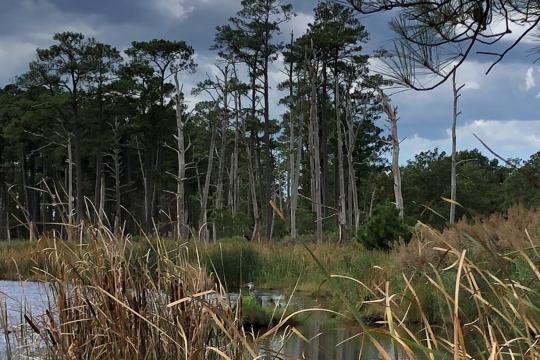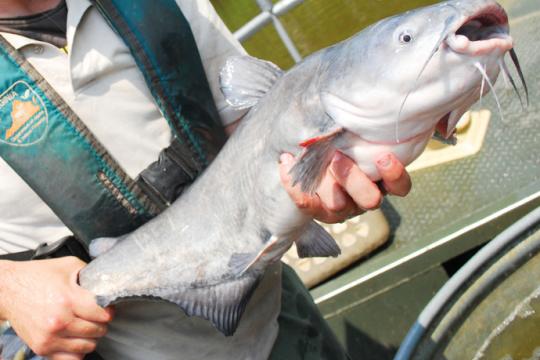Where Does the Blue Catfish Live What Time of Year Does the King Ran Reproduce
Blue Catfish

About the Species
Blue catfish can be found in the waters of many states—both coastal and inland. Native to the Mississippi, Missouri, Ohio, and Rio Grande river basins, they have been introduced to other areas, primarily to serve as a recreational fishing target. Many anglers like fishing for blue catfish because they are strong, savvy fish that are a good challenge.
But in some areas, blue catfish can pose major challenges. Blue catfish were introduced to a few rivers in the Chesapeake Bay watershed decades ago. It was thought that these fish only lived in very fresh water. But they can tolerate water that is not completely fresh. That means that they can swim out of one river, into the more brackish Bay, and then into a different fairly fresh river. As a result, these fish have expanded their range throughout the Chesapeake. They grow large and eat many native species, so they have the potential to cause a lot of harm to the Chesapeake Bay ecosystem.
Lucky for humans, they are quite tasty and a good source of nutrition. States in the Chesapeake Bay watershed are working together to encourage recreational fishing for these catfish—and to develop and grow a commercial fishery as well.
Population Status
- Blue catfish are native to the Mississippi, Missouri, Ohio, and Rio Grande river basins; they have been stocked for fishing in nearly 20 states.
- In the Chesapeake Bay, blue catfish are considered an invasive species. They have expanded their range and population so much that they are likely negatively affecting the Bay ecosystem because they eat so many native species, such as striped bass, blue crab, shad, herring, and Atlantic sturgeon.
Appearance
- Blue catfish have a flat dorsal fin and a deeply forked tail. They are silvery-blue in color with a white belly. Their smooth skin lacks scales.
- Blue catfish have four pairs of black whisker-like barbels around their mouths.
- While adults usually grow to be less than 2 feet long, they can grow to be 5 feet long and weigh more than 100 pounds.
Biology
- Blue catfish can grow to be larger than 100 pounds. One caught in an inland lake on the Virginia–North Carolina border weighed 143 pounds. The Chesapeake Bay record is a blue catfish caught in the James River that was 102 pounds.
- Blue catfish are highly productive and create high numbers of offspring each reproductive cycle. They spawn once a year from late May into June, mostly in lower-salinity streams and smaller tributaries. Females produce 4,000 to 8,000 eggs per kilogram of body weight—so a 10-pound fish could produce more than 20,000 eggs.
- Blue catfish are apex predators of Chesapeake tributaries; they are opportunistic and generalist predators, feeding on important native fish such as menhaden, shad, river herring, as well as blue crabs, plants, and insects.
- Adult blue catfish have few natural predators in the Chesapeake Bay. They are among the preferred prey of osprey and bald eagles.
- Blue catfish are native to the Mississippi, Missouri, Ohio, and Rio Grande river basins.
- Blue catfish have been stocked as a recreational catch in almost 20 states. During the 1970s and 1980s, they were introduced to the James, Rappahannock, and York river basins in Virginia as a new recreational fishery.
- These catfish have quickly spread throughout the Chesapeake Bay watershed into nearly every major tributary.
- They are bottom-dwellers that prefer large rivers with deep channels, swift currents, and sandy bottoms.
- Blue catfish prefer fresher water but can thrive in higher salinities as well. This allows them to move throughout different parts of the Chesapeake Bay where they interact with commercial and ecological important species. They have been documented interfering with gill net fisheries, such as striped bass.
Fishery Management
- Because blue catfish—and another invasive fish, the flathead catfish—have the potential to cause substantial harm to the Chesapeake Bay food web, the Chesapeake Bay Program recently developed an Invasive Catfish Management Strategy (PDF, 21 pages). Their Invasive Catfish Workgroup will continue to work together to focus on this topic.
- Blue catfish are a tasty and nutritious fish, so the Management Strategy recommends that the Chesapeake Bay states focus on developing and expanding commercial fisheries for blue catfish.
- Blue catfish are currently available for sale to the public in many food outlets.
Last updated by NOAA Fisheries on 05/19/2022
Featured News
 As salt water intrudes into marshy areas, some trees are unable to survive. Photo by Alison Hammer.
As salt water intrudes into marshy areas, some trees are unable to survive. Photo by Alison Hammer.
 A scientist holds a blue catfish. Credit: Chesapeake Bay Program.
A scientist holds a blue catfish. Credit: Chesapeake Bay Program.

Recreational Fishing Regulations
In the Chesapeake Bay, blue catfish are a popular recreational fishery. They are primarily fished using hook and line. Guide services in the James and Potomac rivers run expeditions that target blue catfish. Regional and national tournaments are held annually on the James River, and the Potomac River is nearly a year-round hotspot for catfish angling.
In some parts of the Chesapeake Bay, catch and release of these fish is discouraged; instead, anglers are encouraged to remove and kill. It is illegal to transport them from one body of water to another.
Recreational fishermen in other areas, particularly those where blue catfish are native, also enjoy angling for these fish.
Last updated by NOAA Fisheries on 05/19/2022
Commercial Fishing Regulations
Blue catfish are abundant. Catching and eating this invasive species may contribute to needed population control. They are tasty and nutritious.
In the early 2000s, commercial fishing interest in blue catfish was low due to low market demand and lack of consumer awareness of the fish. But now, thanks to marketing efforts, particularly in Maryland, the commercial fishery for blue catfish in the Chesapeake Bay is ramping up.
Jurisdictions that manage fisheries in the Chesapeake Bay work together to discuss the latest fisheries science and coordinate their regulations through the Chesapeake Bay Program. The Chesapeake Bay Program recently released its Invasive Catfish Management Strategy (PDF, 21 pages) to guide the management of blue catfish in the Bay, and an Invasive Catfish Workgroup meets frequently as well.
Commercial Gear Information
Blue catfish are landed commercially using a variety of nets, impoundments, and traps. There is minimal bycatch.
Electrofishing efforts have caught upwards of 6,000 fish in an hour.
Last updated by NOAA Fisheries on 05/19/2022
Subsistence Fishing Regulations
Last updated by NOAA Fisheries on 05/19/2022
Last updated by NOAA Fisheries on 05/19/2022
Management Overview
The Invasive Catfish Workgroup of the Chesapeake Bay Program's Sustainable Fisheries Goal Implementation Team has developed an Invasive Catfish Management Strategy (PDF, 21 pages) to provide collaborative guidance on how Chesapeake states will manage this resource. While recreational fishermen have targeted blue catfish for decades in the Chesapeake Bay, development of a commercial fishery management plan is relatively new. While blue catfish are offered for sale to the public at many stores and markets, the fishery is still developing.
Last updated by NOAA Fisheries on 05/19/2022
Science Overview
Last updated by NOAA Fisheries on 05/19/2022
Source: https://www.fisheries.noaa.gov/species/blue-catfish
0 Response to "Where Does the Blue Catfish Live What Time of Year Does the King Ran Reproduce"
Post a Comment